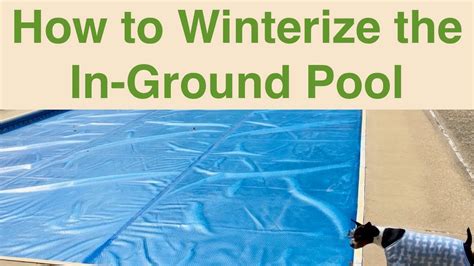How To Winterize An Inground Saltwater Pool
Ronan Farrow
Apr 03, 2025 · 3 min read

Table of Contents
How to Winterize Your Inground Saltwater Pool: A Complete Guide
Winterizing your inground saltwater pool might seem daunting, but with the right steps, it's a manageable process that protects your investment and ensures a sparkling pool come springtime. This guide provides a comprehensive walkthrough, covering everything from initial chemical balancing to final cover installation.
Preparing Your Saltwater Pool for Winter
Before you begin the physical process of winterizing, it's crucial to ensure your pool's water chemistry is perfectly balanced. Improper chemical levels can lead to damage during the winter months.
1. Test and Adjust Water Chemistry
- Ideal Levels: Aim for the following before winterizing: Total alkalinity between 80-120 ppm, pH between 7.2-7.8, and calcium hardness within the recommended range for your pool type. A slightly higher pH (around 7.5-7.8) is beneficial for winter. Consult your pool's manual or a professional for specific recommendations.
- Balancing Chemicals: Use pool chemicals to adjust the levels as needed. Remember to add chemicals slowly and always follow the manufacturer's instructions. Allow sufficient time for the chemicals to fully dissolve and distribute evenly throughout the pool before proceeding.
2. Clean Your Pool Thoroughly
A clean pool is essential for successful winterization. Remove all debris, leaves, and other contaminants from the pool's surface and bottom. Brush the walls and floor thoroughly to dislodge any algae or other buildup. This minimizes the risk of staining and damage over the winter.
3. Shock Treatment
A strong shock treatment helps eliminate any remaining algae or bacteria that could potentially thrive during the winter. Follow the product instructions for the proper amount to add, based on your pool's volume. Allow the shock to circulate for at least 24 hours before proceeding.
Winterizing Your Saltwater Pool: The Physical Process
Now that your pool's water chemistry is balanced and it’s clean, you can begin the physical process of winterization. This involves lowering the water level and protecting the equipment.
1. Lower the Water Level
Lower the water level in your pool by approximately 6 inches below the skimmer. This prevents water from freezing and damaging the pool’s walls and equipment.
2. Protect Your Equipment
- Pump and Filter: Drain the water from your pump and filter, and store them in a frost-free location.
- Pipes: Blow out any remaining water in your pipes using an air compressor. This prevents freezing and potential cracking. If you're unsure about this process, it is advisable to consult a pool professional.
- Automatic Pool Cleaners: Remove and store any automatic pool cleaners, ensuring they are completely dry.
3. Add Winterizing Chemicals (Optional)
Some pool owners choose to add a winterizing chemical to help prevent algae growth during winter. This is optional but can provide an added layer of protection. Always follow the manufacturer's instructions carefully.
Closing and Securing Your Pool for Winter
The final steps involve properly securing your pool for the winter months.
1. Install the Winter Pool Cover
Carefully install your winter pool cover, ensuring it's securely fastened and weighted down to prevent it from being blown away by wind. This is critical to preventing debris from entering the pool.
2. Regularly Inspect Your Pool
While your pool is winterized, it's a good idea to periodically check on it, particularly after heavy snowfalls or periods of freezing rain. Ensure the cover remains intact and that no significant debris has accumulated on it.
Maintaining Your Saltwater Chlorinator During Winter
Your saltwater chlorinator typically does not require special winterization. However, it's a good idea to switch off the power supply to the chlorinator and disconnect it from the pool system before the winter season to prevent electrical surges.
By following these steps, you can successfully winterize your inground saltwater pool, protecting it from winter's harsh elements and ensuring it's ready for use when spring arrives. Remember, if you are uncomfortable with any aspect of this process, consult a qualified pool professional. They can provide expert advice and ensure your pool is properly winterized.
Featured Posts
Also read the following articles
| Article Title | Date |
|---|---|
| Fly Tying Tools And How To Use Them | Apr 03, 2025 |
| How To Wash Lace Curtains | Apr 03, 2025 |
| How Big Is 9x11 | Apr 03, 2025 |
| How To Turn Off Seatbelt Alarm 2024 Chevy Silverado | Apr 03, 2025 |
| How Common Are Gum Grafts | Apr 03, 2025 |
Latest Posts
-
How Does Bail Bond Work In Georgia
Apr 04, 2025
-
How Does Auto 4wd Work On Silverado
Apr 04, 2025
-
How Does Attachment Affect Sleep
Apr 04, 2025
-
How Does An Exposed Nerve Look Like
Apr 04, 2025
-
How Does An Emergency Pick Up Order Work
Apr 04, 2025
Thank you for visiting our website which covers about How To Winterize An Inground Saltwater Pool . We hope the information provided has been useful to you. Feel free to contact us if you have any questions or need further assistance. See you next time and don't miss to bookmark.
